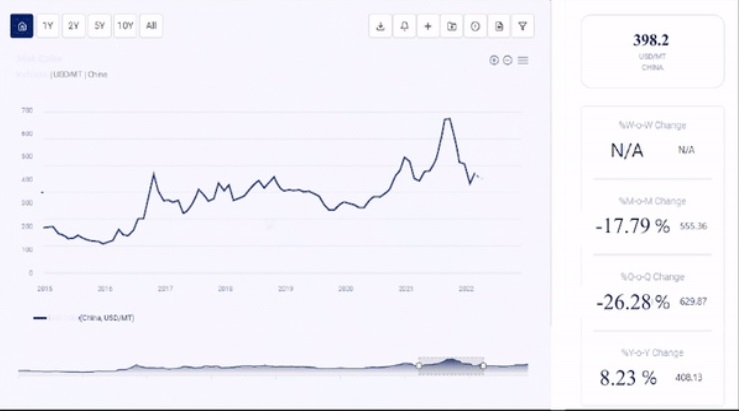Bio-ethanol, a renewable energy source derived from plant materials, has become a significant player in the global energy market. It offers an eco-friendly alternative to fossil fuels and has been increasingly adopted in various industries, particularly in transportation and energy production. This blog explores the price trends of bio-ethanol, providing an in-depth analysis of the market, forecasting future trends, and presenting a comprehensive price chart.
Forecast
The bio-ethanol market has shown considerable volatility over the past few years, influenced by a variety of factors including agricultural yield, crude oil prices, government policies, and technological advancements. According to industry analysts, the global bio-ethanol market is expected to continue its growth trajectory, driven by increasing environmental awareness and the push for sustainable energy sources.
Request For Sample: https://www.procurementresource.com/resource-center/bio-ethanol-price-trends/pricerequest
Short-term Forecast
In the short term, bio-ethanol prices are anticipated to remain stable with a slight upward trend. This stability can be attributed to steady demand from the automotive sector, where bio-ethanol is used as a fuel additive to reduce emissions. Additionally, government mandates and subsidies for renewable energy are likely to support prices.
Long-term Forecast
Over the long term, the bio-ethanol market is expected to witness significant growth. Advances in bio-ethanol production technologies, such as the development of cellulosic ethanol, which utilizes non-food plant materials, are likely to reduce production costs and increase supply. Furthermore, the global shift towards cleaner energy sources and stringent regulations on carbon emissions will bolster the demand for bio-ethanol, potentially driving up prices.
Market Analysis
The bio-ethanol market is influenced by a complex interplay of supply and demand dynamics, regulatory frameworks, and technological advancements. A detailed market analysis helps in understanding the key drivers and challenges affecting bio-ethanol prices.
Supply and Demand Dynamics
The supply of bio-ethanol is heavily dependent on the availability of feedstock, such as corn, sugarcane, and other biomass. Weather conditions, agricultural productivity, and geopolitical factors can significantly impact feedstock availability and, consequently, bio-ethanol production. On the demand side, the transportation sector remains the largest consumer of bio-ethanol, driven by the need for cleaner fuel alternatives. Additionally, the use of bio-ethanol in industrial applications and the beverage industry also contributes to demand.
Regulatory Frameworks
Government policies and regulations play a crucial role in shaping the bio-ethanol market. In many countries, bio-ethanol blending mandates require a certain percentage of ethanol to be mixed with gasoline, driving demand. Subsidies and tax incentives for bio-ethanol production further support market growth. Conversely, changes in policy or reductions in subsidies can negatively impact bio-ethanol prices.
Technological Advancements
Technological innovations in bio-ethanol production have the potential to significantly influence market dynamics. The development of second-generation bio-ethanol, which uses non-food biomass, and third-generation bio-ethanol, derived from algae, could lower production costs and increase supply. These advancements are likely to make bio-ethanol more competitive with fossil fuels, supporting price stability and growth.
Global Market Trends
The bio-ethanol market is characterized by regional disparities in production and consumption. North America, particularly the United States, is a leading producer and consumer of bio-ethanol, driven by agricultural abundance and favorable policies. Brazil is another major player, with its sugarcane-based ethanol industry. Europe and Asia-Pacific are also witnessing growth in bio-ethanol demand, supported by environmental regulations and increasing energy needs.
Price Chart
A comprehensive price chart of bio-ethanol provides valuable insights into historical trends and helps in predicting future movements. The chart below illustrates the price trend of bio-ethanol over the past five years.
Historical Price Trends
- 2018-2019: Bio-ethanol prices experienced moderate growth, supported by stable agricultural yields and steady demand from the transportation sector.
- 2019-2020: Prices saw a slight dip due to an oversupply of feedstock and lower crude oil prices, which reduced the competitiveness of bio-ethanol as a fuel alternative.
- 2020-2021: The COVID-19 pandemic led to significant market disruptions, causing a temporary decline in bio-ethanol prices. Reduced transportation activity and supply chain disruptions impacted demand and production.
- 2021-2022: As the global economy began to recover, bio-ethanol prices rebounded, driven by increasing fuel consumption and supportive government policies.
- 2022-2023: Prices stabilized, with a slight upward trend, reflecting improved agricultural productivity and growing demand for renewable energy sources.
Current Price Analysis
As of mid-2024, bio-ethanol prices are showing a steady increase. The current market conditions, including favorable weather patterns for feedstock crops and strong demand from the automotive sector, are supporting this trend. Additionally, ongoing advancements in bio-ethanol production technologies are expected to enhance supply, contributing to price stability.
Future Price Projections
Looking ahead, bio-ethanol prices are projected to maintain an upward trajectory. The increasing adoption of bio-ethanol in emerging markets, coupled with stringent environmental regulations, will drive demand. Technological innovations and improvements in production efficiency are likely to support supply, ensuring a balanced market and steady price growth.
Conclusion
The bio-ethanol market is poised for significant growth, driven by increasing demand for sustainable energy sources and technological advancements in production. While the market has experienced volatility in the past, current trends indicate a stable and upward price movement. Understanding the factors influencing bio-ethanol prices, including supply and demand dynamics, regulatory frameworks, and technological innovations, is crucial for stakeholders in the energy sector. The provided price chart offers valuable insights into historical trends and future projections, helping businesses and investors make informed decisions in the bio-ethanol market.

